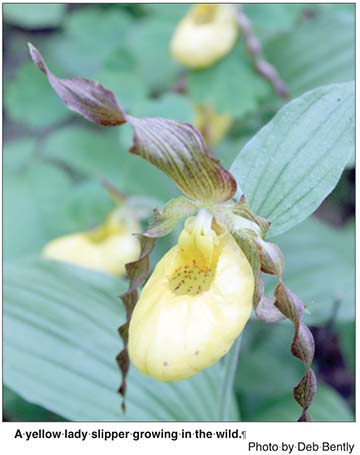 The yellow lady slipper flower was only a concept to me until this past weekend.
The yellow lady slipper flower was only a concept to me until this past weekend.
I have taken a fair number of pictures of our state flower, the pink lady slipper. I have challenged myself to capture its subtle shading from a strong pink at the tip to white at the stem. I have been amazed by its shape, almost like a tiny inflated balloon. It is a wild orchid, and since I am used to thinking of orchids as delicate, sensitive flowers which require careful attention, I am entranced that the wild plant can flourish as it does.
So when it comes to the pink lady slipper, I had met some in person at least eight or ten times, and found it a privilege to make their acquaintance.
This year, I received a texted photo from a friend. In the picture, which was taken in the woods alongside her driveway, were at least 100 yellow lady slipper blooms in two large clusters a few feet apart. My response, to deliver the essence of the message, was “I’ll be right over.”
As I arrived in the vicinity of my friend’s house, I came across some scattered clusters of two or three flowers. They were right alongside the road–fortunately for me, a rather narrow, isolated gravel road which sees relatively little traffic.
I moved from flower to flower, repeatedly getting down on my knees to try and get a picture from the direct front of the blooms, whose stems were probably 18 inches tall.
If any drivers had come along, they might have been concerned for my sanity, since, even though I was alone at the time, I kept commenting out loud about how unusual and beautiful the flowers were. I asked them questions like, “How do you do that?” and “Can you be transplanted?”
The familiar “tiny inflated balloon” shape (I’m told the correct term is “labellum,”), was identical to the pink versions I had photographed before. Familiar, but continually fascinating.
What was different was that, where the pink version has three broad white petals up behind it–like a tiara on a beauty queen–the yellow flower has narrow, spiraling appendages which, rather than a crown, are reminiscent of curly sideburns and a beard. Or maybe braided pigtails, since they hang down rather than fanning upwards. Their beautifully symmetrical twists extend quite a bit below the bottom of the flower.
Online descriptions refer to the spiraled parts as “sepals and petals.” Me, I had trouble looking away. The spirals did not have the graceful elegance of the pink lady slippers’ petals; instead they had an insistent independence about them. “I choose not to look like other flowers,” they seemed to declare. “Appreciate me.”
When I caught up with my friend, she showed me the robust collections from her along-the-driveway photographs. They took my breath away. I was on my knees again, looking for angles and lighting that would help the two-dimensional pictures in representing the physical–and even spiritual–reality of what was in front of me.
I was deeply grateful to be there, and equally grateful to have learned that not all lady slippers are alike.
